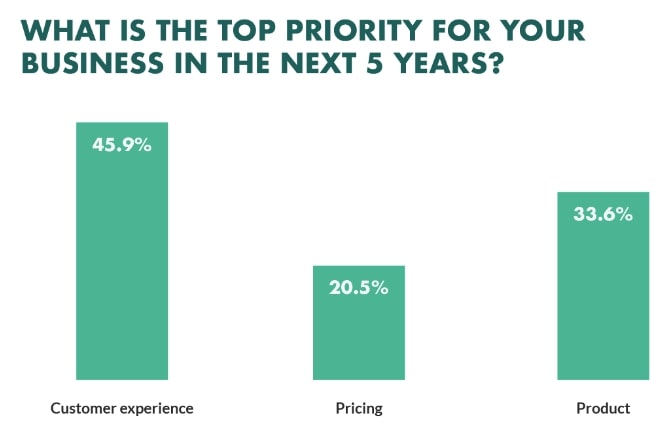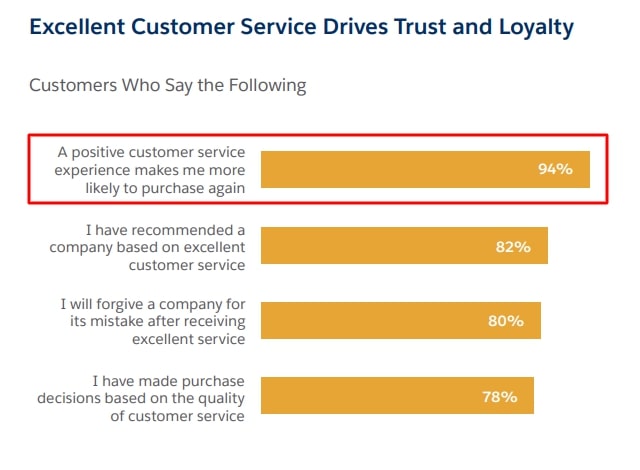Customer success is central to the success of a business.
The more customers experience success with your product, the more they’ll use it and recommend it to others. This will lead to more referrals, less churn, and ultimately more revenue for your business.
Customer success has become a key priority for businesses lately because of the intense competition in most industries. Users now have more options than ever before and businesses have to work harder to retain them as customers.
By implementing effective customer success initiatives, you can help customers gain maximum value from your product, thus increasing customer happiness.
This article examines what customer success is and why it’s important, and shares valuable tips to build a customer success strategy.
What is Customer Success?
Customer success is a business strategy focused on ensuring customers achieve success using your products or services.
When customers can successfully use your product to achieve their business objectives, they will love your solution and continue using it in the long run. This is a great way to build customer loyalty for business.
To get to this point, you must proactively build a strong relationship with your customers. Take time to understand your customers and how your product can help them achieve their goals.
Each interaction should be a valuable opportunity to listen to your customers and address their concerns. That’s why customer success initiatives should be handled by a dedicated team whose role is to help customers use your product effectively.
Customer success teams work closely with the product teams to ensure customer issues are addressed promptly. This leads to greater customer satisfaction, igniting beneficial outcomes for all parties.
Why Should Businesses Prioritize Customer Success?
The success of a business is tied to the success of its customers. When customers can confidently use your product to achieve their objectives, they’ll not be willing to let go of it.
Businesses are increasingly understanding the value of customer success and are actively incorporating it into their business models.
In a recent study by SuperOffice, customer experience emerged as the top priority for businesses over the next five years, outperforming pricing and product.
In today’s competitive environment, where customers are spoiled for choice, customer success has become a key competitive differentiator.
As such, you must find ways to educate and guide your customers on how to gain maximum value from the products they’ve purchased.
This will not only lead to improved customer satisfaction but will also help your business achieve top-level goals, such as:
- Increased subscription renewal rates
- Increased customer loyalty and retention
- Increased customer lifetime value
- Increased monthly recurring revenue (MRR)
- Reduced churn
Customer success initiatives also help businesses collect valuable insights that can benefit the organization.
The more your business understands its customers and their needs, the better positioned it’ll be to deliver exceptional user experiences. This will, in turn, will help you:
- Build stronger customer relationships
- Earn customer trust
- Improve customer satisfaction
Happy and satisfied customers often become advocates who rave about your brand on social media and review sites. This will simplify your B2C or B2B sales lead generation efforts since prospective clients will come to you with pre-established trust courtesy of the positive reviews by your happy customers.
Customer Success vs. Customer Experience vs. Customer Service vs. Account Management
While there are similarities with other customer-facing initiatives, you shouldn’t confuse customer success with other similar terms.
To help you make the distinction, here are brief explanations of customer success, customer experience, customer service, and account management.
Customer Success
Customer success focuses on helping customers become advanced users of your product so they can achieve their goals effectively.
CS initiatives proactively seek opportunities to help customers succeed with your product by collecting as much client data as possible.
Insights from the data also inform business strategy. You can use the insights to understand your customers and find ways to serve them better.
The key responsibilities of customer success teams include:
- Customer onboarding
- Education
- Value delivery
- Proactive engagement
- Customer advocacy
Customer Experience
The other customer-facing function that’s often confused with customer success is customer experience.
While customer success focuses on the end result of the customer journey—helping users find value in your product, customer experience strategies focus on the broader customer journey.
CX teams identify and resolve the issues along the customer journey and seek ways to make each interaction pleasant.
Customer experience initiatives include activities like user interface testing, website responsiveness, navigation, and overall satisfaction throughout the customer journey.
Customer Service
Customer service is a reactive business function where businesses handle customer complaints and help customers solve their issues.
Excellent customer service is crucial to the success of an organization. A Salesforce survey found that 94% of customers are more likely to purchase again because of positive customer service.
Customer support agents are usually needed after users experience a problem, and their role is to offer immediate assistance to resolve issues. In such cases, the agents create tickets and provide information to resolve existing problems.
On the contrary, customer success is proactive and aims to anticipate and solve problems before customers reach out.
Account Management
Like customer service, account management offers reactive support to customers on a case-by-case basis.
But unlike support teams that aim to solve problems and exit the scene quietly, account managers focus on making as much money as possible from a few dedicated accounts.
Typically, these are high-value accounts that can grow substantially with dedicated support. As such, account managers offer them personalized support and tailored solutions to grow these accounts and generate more revenue for the business.
How to Make Customer Success Work for Your Business
Follow these steps to create a customer success program that will spur sustainable growth for your business.
1. Create a Customer Success Strategy
The first thing you need to do is create a customer success strategy for your business. Define what success means for your customers and create a strategy to help them succeed.
According to Attrock, brands can retain their customers using robust customer retention strategies that are already being used by big brands such as JetBlue, Starbucks, Niantic, and many more.
In this case, the business can help the clients succeed by improving the abandoned cart retrieval feature to encourage shoppers to complete their purchases.
Here’s an example of an abandoned cart email aimed at re-engaging prospects.
Besides identifying the product features customers use regularly and improving them, the other things to include in your customer success strategy are:
- Preferred communication channels: The best ways to reach out to customers and ensure they receive timely and relevant support.
- Preferred content formats: How to present information in a manner that resonates with your audience, whether it’s through articles, videos, webinars, or other means.
- Current customer experience: The customer journey map for your business and key areas of improvement.
Potential impact of your CS initiatives: The end goals you want to achieve by implementing your customer success strategy.
2. Get Robust Customer Success Software
To ensure customer success, you need to track how customers interact with your product and learn what you can improve to help them gain maximum value from it.
For this, you will need a customer success software solution that connects with your product. This will help you monitor user activity to understand how customers are using your product to achieve their goals.
Besides helping you discover features that are popular with your customers, it will also help you discover the features they hardly use. This information will guide you to make informed decisions to improve your product.
For example, you may find that customers don’t use a certain feature because they don’t know how to use it. This will guide you to initiate a plan to educate users on how to use that particular feature.
Additionally, the customer success software solution can facilitate proactive engagement with customers.
By providing insights into usage patterns, the software solution allows you to make timely interventions to solve issues before they become a major concern.
3. Emphasize Customer Success as a Key Organization Goal
While it’s important to have a dedicated customer success team in place, it’s equally vital to make customer success a top priority for the entire organization.
Everyone, from sales to engineering, must integrate customer success into everything they do.
To achieve this, you should educate everyone in the organization about customer success and the role it plays in business growth. What’s more, educate them on how they can ensure customer success in their respective roles.
For instance, the engineering team can streamline product design to ensure simplicity and empower customers to achieve their goals effortlessly.
Similarly, the sales team can focus on communicating how the product is tailored to help customers achieve their goals and maximize ROI.
Once everyone is on board, it becomes easy to put in place customer-centric measures that benefit everyone.
4. Create a Dedicated CS Team
Having a customer success team is vital for organizations that want to help customers succeed with their products. The whole organization can be customer-focused but you still need a dedicated team to spearhead these efforts.
For small businesses, the customer success team can be just one person with relevant experience helping customers realize value from their purchases.
But for large enterprises with subscription-based products, this should be a larger department with the following members:
- Customer success managers
- Customer success operation leaders
- Onboarding representatives
- Training representatives
- Professional services experts
- Upsell and cross-sell representatives
Bringing in all these experts will help you be proactive when dealing with customer issues, leading to greater customer satisfaction.
5. Track and Share Data With Other Teams
Customer success is a data-driven business function. You can only succeed with your customer success initiatives by actively tracking the right customer metrics and sharing the data with other departments in the organization.
The customer metrics you need to monitor include:
- Customer lifetime value
- Repeat purchase rate
- Customer retention rate
- Customer retention cost
- Churn rate
- Customer health score
- Net promoter score
- Customer satisfaction score
- Customer effort score
Insights from these data points will guide you to make informed decisions to improve your offerings and serve your customers better. For instance, the customer effort score (CES) will help you learn if your product is easy to use or not.
You can obtain the CES score by asking customers how easy your business made it to solve their issues through a survey. Customers then rate their experience through a numerical scale of 1-7 as shown in the image below.

If you find that your product is not as easy to use as you expected, you can share this data with the product team and ask them to make user-friendly improvements.
6. Create a Referral Program
After implementing the initiatives in this post to make your customers happy, you can start a referral program to harness their enthusiasm to attract new customers.
First, you’ll need a good referral management software solution to launch your program. Second, you’ll need to design an interactive and gamified program that offers lucrative incentives.
For example, you can give customers an incremental discount on their next renewal for every customer they successfully refer to you.
Conclusion
Customer success is a key driver of business growth. When you help customers succeed with your product, they’ll stay loyal to your brand and rave about your product to others.
To achieve this at the highest level, make customer success a top priority for your business and build a dedicated team to lead your CS efforts. Also, track the relevant customer success metrics and use the insights to improve your offering.
These strategies will help you increase customer happiness and drive sustainable growth for your business.








